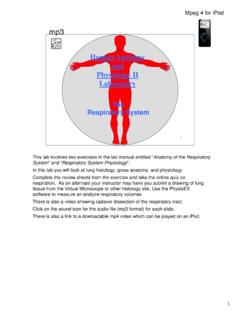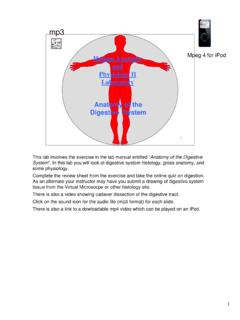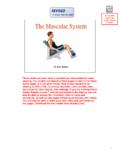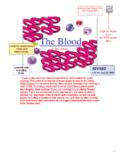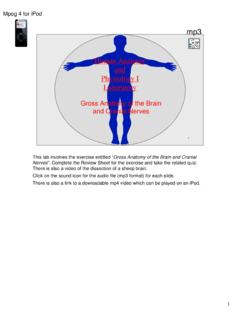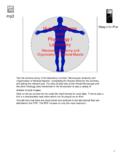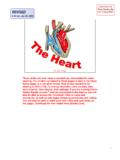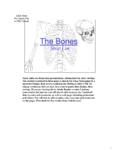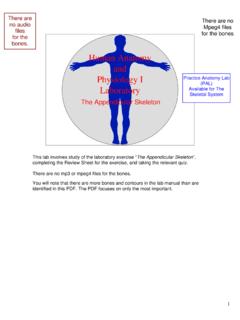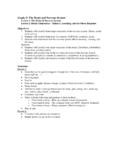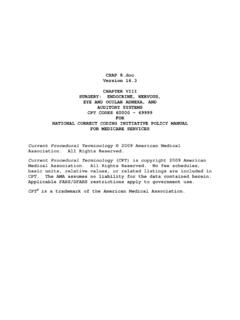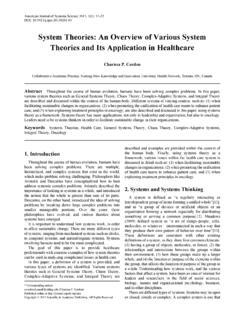Transcription of 1 © Jim Swan - Class Videos
1 11 Jim Swan These slides are from Class presentations, reformatted for static viewing. The content contained in these pages is also in the Class Notes pages in a narrative format. Best screen resolution for viewing is 1024 x 768. To change resolution click on start, then control panel, then display, then you are viewing this in Adobe Reader version 7 and are connected to the internet you will also be able to access the enriched links to notes and comments, as well as web pages including animations and Videos . You will also be able to make your own notes and comments on the pages. Download the free reader from [ ]22 Functions of the nervous System1) Integration of body processes 2) Control of voluntary effectors (skeletal muscles), and mediation of voluntary ) Control of involuntary effectors ( smooth muscle, cardiac muscle, glands) and mediation of autonomic reflexes (heart rate, blood pressure, glandular secretion, etc.) 4) Response to stimuli 5) Responsible for conscious thought and perception, emotions, personality, the mind.
2 These functions relate to control of the skeletal muscles discussed in Unit 2 as well as future discussion of reflexes, the brain, and the autonomic nervous system . 33 Structural Divisions of the nervous SystemCentral nervous system (CNS)BrainSpinal Cord Peripheral nervous system (PNS)nerves, ganglia, receptorsThe central nervous system develops from the neural tube, while the peripheral nervous system develops from the neural crest Divisions of the nervous System1) The Voluntary nervous system - ( somatic division) willful control of effectors (skeletal muscles), and conscious perception. Mediates voluntary reflexes. 2) The Autonomic nervous system - control of autonomic effectors - smooth muscles, cardiac muscle, glands. Responsible for "visceral" reflexes. The functional divisions and structural divisions overlap, the voluntary and autonomic nervous systems both use portions of the CNS and in the nervous System1) Neurons- the functional cells of the nervous system .
3 See below. 2) Neuroglia(glial cells) - Long described as supporting cells of the nervous system , there is also a functional interdependence of neuroglial cells and neurons. 1) Neuronscome in several varieties which we will cover ) Neuroglia(glial cells) - Long described as supporting cells of the nervous system , there is also a functional interdependence of neuroglial cells and neurons. [See Glioma Tumors] 66 Types of Glial Cells the CNSF igure 8-1astrocytes- these cells anchor neurons to blood vessels, regulate the micro-environment of neurons, and regulate transport of nutrients and wastes to and from neurons. Part of Blood-brain Barrier .microglia- these cells are phagocytic to defend against pathogens. They may also monitor the condition of neurons. These glial cells look a lot like neurons in their structure. But they are derived mostly from the ectodermand have supporting only part of the basis for the Blood-Brain barrier. The capillaries of in the brain have extremely tight junctions.
4 Substances must pass through the capillary wall cells by endocytosisand exocytosis. Also known as spyder cellsdue to their as macrophages when they migrate to damaged brain tissue. Also known as gitter cells, they are often packed with lipoid granules from phagocytosis of damaged brain Cells of the CNS (contd.)Figure 8-1ependymalcells - these cells line the fluid-filled cavities of the brain and spinal cord. They play a role in production, transport, and circulation of the cerebrospinal fluid. oligodendrocyte- produce the myelin sheath in the CNS which insulates and protects the processes on theependymal cells. They possess stereocilia, which are a combination of ciliaand microvilli. They provide the surface area for secretion and absorption to manage the cerebrospinal fluid, and they help to circulate the fluid by their name of the oligodendrocytesmeans few processes . These cells wrap around CNS neurons to produce the myelin sheath.
5 The sheath in PNS is produced by Schwann cells. Diseases which destroy the myelin sheath lead to inability to control muscles, perceive stimuli etc. One such disease is [multiple sclerosis], an autoimmune disorder in which your own lymphocytes attack the myelin proteins. 88 Glial Cells: AstrocytesAstrocytes are star-shaped glial cells of the CNS which contribute to the blood-brain barrier. Note the star pattern of these cells, which reach out to connect to both capillaries and and CapillariesAstrocytesCapillaries Note their close relationship to capillaries, the heavy black structures. Since astrocytestouch both capillaries and neurons, they are thought to play animportant intermediary role in the nutrition and metabolism of neurons. 1010 Ependymal Cells Line Cavities in the CNSThe central canal in the spinal cord contains cerebrospinal fluid (CSF) and its lumen is lined with ependymal the tiny stereocilia of the ependymal Glial CellsFigure 8-1 Schwann cells- produce the myelin sheath in the PNS.
6 The myelin sheath protects and insulates axons, maintains their micro-environment, and enables them to regenerate and re-establish connection with receptors or effectors. Enables saltatory cells- surround cell bodies of neurons in ganglia. Their role is to maintain the micro-environment and provide insulation for the ganglion cells. Satellite cells are important in many tissues in providing for repair or replacement of damaged cellsgrow around the nerve fibers in the embryo, forming concentric layers called the myelin sheath. 1212 Satellite Cells are Glial Cells in the Dorsal Root GanglionA high magnification shows the satellite cells which surround the nuclei of dorsal root ganglion cells. This is a section of a spinal or dorsal root ganglion which contain the cell bodies for spinal sensory CellsFigure cell nucleusSchwann cell cytoplasmNeurilemma the outer layer of the Schwann cellMyelin sheath inner wrappings of the Schwann cellSchwann cellsare glial cells which produce the myelin sheath in peripheral nerve fibers.
7 A myelinated fiber is one with many layers of Schwann cell wrappings. The myelin sheath insulates fibers and, as we will see later, provide for more rapid conduction (saltatory conduction) and the ability of regeneration after injury. Because of the way they wrap with secreted myelinbetween the layers, this is referred to as the jelly roll Myelinated FibersAxons Small myelinated fibersMyelin sheathIn this nerve cross section most of the axon fibers are seen to be myelinated, surrounded by a myelin sheath composed of Schwann StructureCell body (cyton)Contains Nissl substance: biosynthetic machinery and organelles mostly rough Contains Nissl substance: biosynthetic machinery and organelles mostly rough Figure In order to connect to other cells, receptors, and effectors, neurons have cytoplasmic extensionswhich attach to an enlarged area known as the cell bodyor cyton. Within the cell body is the nucleus and the neuron's biosynthetic machinery, the rough endoplasmic reticulum and the Golgibodies.
8 These organelles are so highly concentrated they can be visualized with a light microscope when stained with a specific technique. Called Nisslsubstanceafter the scientist who invented the staining technique, they manufacture the neurotransmitters which the neuron must secrete in large quantities. The neurotransmitter molecules are transported to the axon terminus by microfilaments and microtubules. 1616 Neuron StructureCell body (cyton)Cytoplasmic extensions:DendritesAxon Figure There are two basic types of cytoplasmic extensions: the dendritesand the axon. Dendrites are short branching processes which receive stimuli from receptors or other neurons. They can perform this function because they, like the exposed membrane of the cell body, possess chemically-gated ion channelswhich respond to stimulation by neurotransmitters. So the dendrites increase the area on which a neuron can be stimulated and together with the rest of the membrane of the cell body constitute the neuron's receptive region(See Table ).
9 1717 Neuron StructureCell body (cyton)Cytoplasmic extensions:DendritesAxon Figure cells only axons in PNS are myelinated in this cells only axons in PNS are myelinated in this of RanvierNucleus A neuron will usually have only one axon, although it may branchextensively. The axon has voltage regulated ion gates(voltage gated ion channels) and therefor is responsible for carrying an impulse to another neuron or effector. The axon represents the neuron's conducting region. At the end of the axon, the axon terminus, is the secretory regionwhere the neurotransmitters are released into the synapse. 77 Multipolar Neurona) Multipolar neuronReceptiveregionConductiveregionSec retoryregionMultipolar neuronsare the most common,found as interneuronsand motor neuronsthroughout the myelinated axonsare found as fibers inmotor regionA multipolar neuronhas many dendrites and one axon. Multipolar neurons are found as motorand interneurons. The receptive region is the region which can be stimulated by a neurotransmitter it has chemically-gated ion channels.
10 The conductive region generates and propagates an action potential it has voltage-gated ion channels. The trigger region is the area where depolarization from the receptive region spreads to the voltage-gated channels of the conductive region. In this area summation of depolarization and hyperpolarization (explained later) can produce enough depolarization to open the voltage regulated gates and produce an action potential. The secretory region has vesicles which release neurotransmitter in response to the arrival of an action Multipolar Neuroncytoplasmicprocessesnucleusnucleol usA multipolar neuron, taken from the anterior horn of the spinal cord gray NeuronNissl substanceNissl substanceis the stained organelles of the neuron s biosynthetic machinery. It is concentrated in the cell bodies of neurons in order to produce the large amounts of neurotransmitter and other substances which must be secreted. 2222 Examples of Multipolar NeuronsMost abundant neruron type in the body: motor neurons in spinal cord and most brain cells integrate pathways by receiving multiple inputs (the dendrites) and integrating them into one output which facilitates or inhibits the next neuron or CNSU nipolarneurons have one process, an axon.
